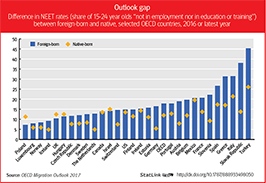Don’t give up

Outlook gap
The deep recession of 2007-08 hit young people hard, but it hit foreign-born youth even harder. While 13.9% native-born 15 to 29-year-olds in OECD countries were neither employed nor in education or training (NEET) in 2015, the rate for foreign-born in that demographic was 21.5%.
That said, foreign-born young people comprise very different populations: some are recently-arrived migrants while others arrived as children with their parents and have been educated in the host-country. However, when comparing NEET rates of foreign to native-born young people, language difficulties are often, if not always, a problem for the latter. And though the recently-arrived may be skilled, their qualifications may be unfamiliar to potential employers.
Now, 10 years later, foreign-born young people are finding themselves not only still unemployed, but increasingly unemployable. In most OECD countries, the gap between the average rate of foreign-born compared to native-born youth that are NEET has increased to 30%, or six percentage points. No wonder a lot of foreign-born young people are simply giving up. In the US, the number of foreign-born 15 to 24 year-olds who are continuing to look for work has fallen by over two percentage points. In Australia, the drop is 3.7 percentage points. Policymakers must do more to improve their outlook, so that foreign-born workers can also contribute more, and look forward to a future of better pay, a quality job, and better health.
©OECD Observer No 311, Q3 2017
